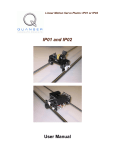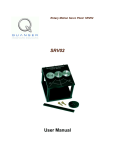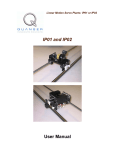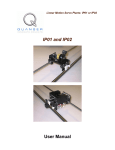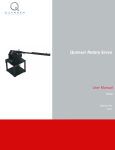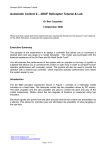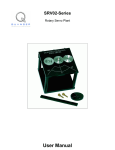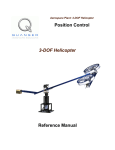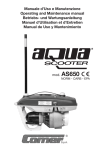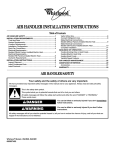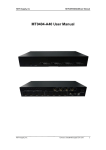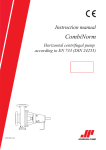Download Active Mass Damper - Two Floors (AMD
Transcript
Linear Motion Servo Plant: AMD-2 Active Mass Damper - Two Floors (AMD-2) User Manual AMD-2 User Manual Table of Contents 1. Active Mass Damper – Two-Floor Structure (AMD-2) Presentation.................................1 1.1. AMD-2: System Description........................................................................................1 1.2. AMD-2: Control Challenge.........................................................................................2 2. References............................................................................................................................2 3. AMD-2 System Description................................................................................................3 3.1. Component Nomenclature...........................................................................................3 3.2. Component Description...............................................................................................5 3.2.1. Flexible Structure (Components #18 And #19)...................................................5 3.2.2. Cart Rack (Components #2, #3, and #5)..............................................................5 3.2.3. Floor Accelerometers (Components # 23 And #25).............................................6 3.2.4. Cart DC Motor (Component #9)..........................................................................6 3.2.5. Cart Planetary Gearbox (Component #17)...........................................................7 3.2.6. IP01-Based Cart Potentiometer............................................................................7 3.2.7. IP02-Based Cart Encoder (Component #10)........................................................7 4. AMD-2 Model Parameters...................................................................................................9 5. Wiring Procedure For The AMD-2 System.......................................................................11 5.1. Cable Nomenclature...................................................................................................11 5.2. Hardware Requirements.............................................................................................13 5.3. Typical Connections For The AMD-2 System...........................................................14 5.3.1. Wiring Of The Cart DC Motor Power Line.......................................................14 5.3.2. Wiring Of The Feedback Signals.......................................................................14 5.3.3. AMD-2 Wiring Summary...................................................................................16 6. Setting Up the AMD-2 Plant.............................................................................................17 7. Obtaining Support..............................................................................................................17 Appendix A. Cart DC Motor Specification Sheet.................................................................18 Appendix B. Cart Planetary Gearhead Specification Sheet...................................................19 Appendix C. IP01-Based Cart Potentiometer Specification Sheet........................................20 Appendix D. IP02-Based Cart Encoder Specification Sheet.................................................21 Document Number: 570 ! Revision: 02 ! Page: i AMD-2 User Manual 1. Active Mass Damper – Two-Floor Structure (AMD-2) Presentation 1.1. AMD-2: System Description The typical Active Mass Damper – Two-Floor structure (AMD-2) plant is depicted in Figure 1. The AMD-2 plant is a bench-scale model to emulate a building controlled by an Active Mass Damper (AMD). The plant consists of a two-story building-like structure on top of which a linear cart (i.e. active mass) is driven by a rack and pinion mechanism. The first and second floors are each instrumented with an accelerometer measuring the accelerations of the middle and top floors, respectively, relative to ground. The structure frame is made of steel and is flexible along its facade. Such a scaled structure has been designed to study critical aspects of structural control implementations. The top (a.k.a. roof) of the structure accommodates a rack and a shaft designed to work with an IP01- or IP02- type of linear cart, which thus constitutes the controllable mass at the top of the structure. The cart is free to move along in the same direction as the structure. Specifically, it is a precisely machined solid aluminum cart which is driven by a high quality DC motor equipped with a planetary gearbox. The cart slides along a stainless steel shaft using linear bearings. When the motor turns, the torque created at the output shaft is translated, through the rack and pinion mechanism, to a linear force (i.e. control force) which results in the cart's motion. The cart position is directly measured using either a potentiometer (for the IP01-based cart) or an encoder (for the IP02-based cart) whose shaft meshes with the track via an additional Figure 1 AMD-2 System pinion. Moreover, two masses are available for attachment to the cart, so that it has more inertia to absorb the structure's vibrations. These two weights can be used or removed for assessing the robustness of the controller and the effects of Document Number: 570 ! Revision: 02 ! Page: 1 AMD-2 User Manual variations in parameters. For more details regarding the IP01 and IP02 linear servo plants and their applications, please review Reference [1]. Different building/linear cart configurations can be constructed, depending for instance on the location of the cart in the structure. Also several Quanser's single-story AMD buildings can be connected either in series or in parallel. Additionally, the flexible system can also be excited using the Quanser Shake Table II, as described in Reference [2]. Of course, those different combinations allow for Multi-Input-Multi-Ouput (MIMO) experiments. 1.2. AMD-2: Control Challenge The AMD-2 plant forms an autonomous servo system. The challenge in designing a control system that dampens out the vibrations in the two-story building-like structure is that the deflections of both first and second floors (or horizontal displacement) are NOT measured. Instead, the structure's feedback sensors are two accelerometers mounted on the AMD-2's middle and top floors. The only other sensor that is available is to measure the linear cart position. The only input to the AMD-2 system is the cart motor voltage. In order to dampen out the vibrations in the AMD-2 flexible structure, the system is supplied with a state-feedback controller based on a full-order observer. The closed-loop control scheme drives the active mass (i.e. linear cart) by taking into account the actual cart position and both floor acceleration feedback signals. Of course, you may design any other controller you wish. The complete mathematical modelling and system parameters are provided to streamline the implementation of the control theory of your choice. 2. References [1] IP01 and IP02 User Manual. [2] Shake Table II Experiment Manual. Document Number: 570 ! Revision: 02 ! Page: 2 AMD-2 User Manual 3. AMD-2 System Description 3.1. Component Nomenclature As a quick nomenclature, Table 1, below, provides a list of all the principal elements composing the Active Mass Damper – Two-Floor system (AMD-2). Every element is located and identified, through a unique identification (ID) number, on the AMD-2 plant represented in Figures 2, 3, 4, and 5, below. ID # Description Description ID # 1 AMD Cart 2 Stainless Steel Shaft 3 Track 4 Linear Bearing 5 Rack End Plate 6 Rack Set Screw: (7/64)" 7 Cart Load Weight 8 Cart Load Weight Set Screw: (3/32)" 9 Cart DC Motor 10 Cart Encoder 11 Cart Motor Pinion 12 Cart Position Pinion 13 Cart Motor Pinion Shaft 14 Cart Position Pinion Shaft 15 Cart Motor Connector 16 Cart Encoder Connector 17 Cart Planetary Gearbox 18 First Floor Flexible Structure 19 Second Floor Flexible Structure 20 Ground Floor 21 First Floor 22 Second Floor 23 First Floor Accelerometer 24 First Floor Accelerometer Connector 25 Second Floor Accelerometer 26 Second Floor Accelerometer Connector 27 Accelerometer Offset Potentiometer 28 Accelerometer Gain Potentiometer Table 1 AMD-2 Component Nomenclature Document Number: 570 ! Revision: 02 ! Page: 3 AMD-2 User Manual Figure 2 AMD-2 Cart: Front View Figure 4 AMD-2 IP02-Type Cart: Bottom View Figure 5 AMD-2 Accelerometer: Bottom View Figure 3 AMD-2 Structure: Front View Document Number: 570 ! Revision: 02 ! Page: 4 AMD-2 User Manual 3.2. Component Description 3.2.1. Flexible Structure (Components #18 And #19) The Active Mass Damper – Two-Floor (AMD-2) structure is made of two identical singlestory modules connected on top of each other (i.e. in series). Each single-story structural module consists of two vertical steel beams. Each steel column has a section of 1.75 by 108.1 millimeters and a mass of 0.240 kilograms. Each single-story frame external dimensions are shown in Table 2, below. Description Value Unit Flexible Module Height 0.50 m Flexible Module Length 0.32 m Flexible Module Depth 0.11 m Table 2 Single-Story Module Dimensions The resulting overall dimensions for the AMD-2 structure are shown in Table 3, below. Description Value Unit AMD-2 Structure Height 1.00 m AMD-2 Structure Length 0.32 m AMD-2 Structure Depth 0.11 m Table 3 AMD-2 Overall Dimensions 3.2.2. Cart Rack (Components #2, #3, and #5) Table 4, below, characterizes the overall dimensions of the cart rack used in the Active Mass Damper – Two-Floor (AMD-2) system. Description Value Unit Overall Cart Rack Length 0.31 m Overall Cart Rack Height 0.13 m Overall Cart Rack Depth 0.11 m Table 4 AMD-2 Cart Rack Overall Dimensions Document Number: 570 ! Revision: 02 ! Page: 5 AMD-2 User Manual 3.2.3. Floor Accelerometers (Components # 23 And #25) Each floor of the building-like structure is equipped with a capacitive DC accelerometer with full-scale range of ±5 g. It consists of a single-chip accelerometer with signal conditioning. The AMD-2 accelerometers are calibrated in-house to generate 1 Volt per 9.81 m/s2 (i.e. 1 V/g), as characterized by the accelerometer sensitivity shown in Table 5, on page 10. The accelerometer has the capability to measure both AC/dynamic accelerations (e.g. vibrations) and DC/static accelerations (e.g. gravity). The arrow represented on the accelerometer, and depicted in Figure 5, shows the positive direction of the AC acceleration sensor measurement on its axis of sensitivity. To best measure the AMD-2 floor vibration, both accelerometers are mounted such their sensitive axes are longitudinal to the structure. Quickly pushing each floor of the AMD-2 plant towards the right, when facing the structure, should result in an initial positive acceleration voltage. Although both AMD-2 accelerometers have already been calibrated at the factory, the signal conditioning circuit properties may vary depending on the external conditions (e.g. humidity, temperature). Therefore, you may want to adjust each accelerometer's Offset potentiometer (shown as component #27 in Figure 5) such that it reads approximately zero Volts with zero acceleration (i.e. sensor resting flat or horizontal). Likewise, each accelerometer's Gain potentiometer (shown as component #28 in Figure 5) can be adjusted to read minus one Volts when the sensor is resting vertically on its right side with the arrow pointing downwards. 3.2.4. Cart DC Motor (Component #9) The AMD-2 cart incorporates a Faulhaber Coreless DC Motor (2338S006), as represented in Figures 2 and 4 by component #9. This model is a high efficiency low inductance motor resulting in a much faster response than a conventional DC motor. The complete specification sheet of the motor is included in Appendix A. CAUTION: High Frequency signals applied to a motor will eventually damage the gearbox and/or the motor brushes. The most likely source for high frequency noise is derivative feedback. If the derivative gain is too high, a noisy voltage will be fed into the motor. To protect your motor, you should always band limit your signal (especially derivative feedback) to a value of 50Hz. Document Number: 570 ! Revision: 02 ! Page: 6 AMD-2 User Manual 3.2.5. Cart Planetary Gearbox (Component #17) The AMD-2 cart DC motor is coupled to a Faulhaber Planetary Gearhead Series 23/1, as represented in Figures 2 and 4 by component #17. Its reduction ratio is 3.71:1. The complete specification sheet of the planetary gearbox is included in Appendix B. 3.2.6. IP01-Based Cart Potentiometer If the AMD-2 cart is based on the IP01 cart, described in Reference [1], its linear position is sensed by a 10-turn black potentiometer, namely the Vishay Spectrol model 534-1-1-103. The cart potentiometer is connected to a ±12 Volt DC power supply through two bias resistors of 7.15 kΩ each. The total output range of the cart position potentiometer results to be ±5V over its 10 complete turns (i.e. 3600 degrees). The main specifications of the IP01based AMD-2 cart potentiometer are included in Appendix C. Refer to Table 5, on page 10, for the resulting potentiometer sensitivity. Pushing manually the AMD-2 cart towards the right side of the track, when facing it, should result in a positive change in the cart position potentiometer voltage. Likewise, pushing the cart towards the left side of the track, when facing it, should result in a decreasing cart position potentiometer voltage. 3.2.7. IP02-Based Cart Encoder (Component #10) If the AMD-2 cart is based on the IP02 cart, described in Reference [1], its linear position is measured with one optical encoder, which is represented in Figure 4 by component #10. The encoder model used in the AMD-2 cart is a US Digital S1 single-ended optical shaft encoder. It offers a high resolution of 4096 counts per revolution (i.e. 1024 lines per revolution with two channels in quadrature). The complete specification sheet of the S1 optical shaft encoder is included in Appendix D. The internal wiring diagram of the cart encoder is depicted in Figure 6. The standard 5-pin DIN connector, shown in Figure 6, is also pictured as component #16 in Figure 2. Document Number: 570 ! Revision: 02 ! Page: 7 AMD-2 User Manual Figure 6 Cart Encoder Wiring Refer to Table 5, on page 10, for the resulting encoder resolution. Pushing manually the AMD-2 cart towards the right side of the track, when facing it, should result in a positive change in the cart position. Likewise, pushing the cart towards the left side of the track, when facing it, should result in a decreasing cart position. Document Number: 570 ! Revision: 02 ! Page: 8 AMD-2 User Manual 4. AMD-2 Model Parameters Table 5, below, lists and characterizes the main parameters (e.g. mechanical and electrical specifications, convertion factors) associated with the Active Mass Damper – Two-Floor (AMD-2) plant. Some of these parameters can be used for mathematical modelling of the AMD-2 system as well as to obtain the structure-plus-cart's Equations Of Motion (EOM). Symbol Description Value Unit Hf1 First Floor Height 0.502 m Hf2 Second (i.e. Top) Floor Height 1.035 m Ms Structure Total Mass (With No Rack And No Cart) 3.300 kg Mf1 First Floor Mass 1.160 kg Mf2 Second Floor Mass (With Rack) 1.380 kg Mr Rack Mass 0.700 kg Mc Cart Mass (With Two Weights) 0.650 kg Mw Cart Weight Mass 0.130 kg Kf1 First Floor Linear Stiffness Constant (Relative To The Ground) 500 N/m Kf2 Second Floor Linear Stiffness Constant (Relative To The First Floor) 500 N/m Tc Cart Travel (i.e. Stroke) 0.19 m Pr Rack Pitch 1.664E-003 m/tooth Vnom Cart Motor Nominal Input Voltage 6.0 V fvmax Cart Motor Input Voltage Maximum Frequency 50 Hz Rm Cart Motor Armature Resistance 2.6 Ω Lm Cart Motor Armature Inductance 0.18 mH Kt Cart Motor Torque Constant 0.00767 N.m/A ηm Cart Motor Efficiency 100 % Km Cart Back-ElectroMotive-Force (EMF) Constant 0.00767 V.s/rad Jm Cart Rotor Moment of Inertia 3.90E-007 kg.m2 Document Number: 570 ! Revision: 02 ! Page: 9 AMD-2 User Manual Symbol Description Value Unit N.s/m Beq Equivalent Viscous Damping Coefficient, as seen at the Motor Pinion 3.0 Kg Cart Planetary Gearbox Gear Ratio 3.71 ηg Cart Planetary Gearbox Efficiency 100 % rmp Cart Motor Pinion Radius 6.35E-003 m Nmp Cart Motor Pinion Number of Teeth rpp Cart Position Pinion Radius Npp Cart Position Pinion Number of Teeth KEC Cart Encoder Resolution (if IP02-Based) KPC Cart Potentiometer Sensitivity (if IP01-Based) KACC Floor Accelerometer Sensitivity 24 1.48E-002 m 56 2.275E-005 m/count 0.0931 m/V 9.81 m/s2/V Table 5 AMD-2 System Paremeters Document Number: 570 ! Revision: 02 ! Page: 10 AMD-2 User Manual 5. Wiring Procedure For The AMD-2 System This section describes the standard wiring procedure for the Active Mass Damper – TwoFloor (AMD-2) plant. The following hardware, accompanying the AMD-2, is assumed: Power Amplifier: Quanser UPM 1503 / UPM 2405 or equivalent. Data Acquisition Card: Quanser Q8 / MultiQ-PCI / MultiQ-3, or one of the National Instruments E-Series cards, or equivalent. 5.1. Cable Nomenclature Table 6, below, provides a description of the standard cables used in the wiring of the AMD-2. Cable Designation Description 5-pin-DIN to RCA This cable connects an analog output of the data acquisition terminal board to the power module for proper power amplification. 4-pin-DIN to 6-pin-DIN This cable connects the output of the power module, after amplification, to the desired actuator (e.g. cart motor). One end of this cable contains a resistor that sets the amplification gain (e.g. 1, 3, 5). Figure 7 "From Digital-To-Analog" Cable Figure 8 "To Load" Cable Of Gain 1 Document Number: 570 ! Revision: 02 ! Page: 11 AMD-2 User Manual Cable Designation Description 5-pin-stereoDIN to 5-pin-stereoDIN This cable carries the encoder signals between the encoder connector and the data acquisition board (to the encoder counter). Namely, these signals are: +5VDC power supply, ground, channel A, and channel B. 6-pin-miniDIN to 6-pin-miniDIN This cable carries analog signals from one or two plant sensors (e.g. floor accelerometer, cart potentiometer) to the UPM, where the signals can be either monitored and/or used by an analog controller. The cable also carries a ±12VDC line from the UPM in order to power a sensor and/or signal conditioning circuitry. 5-pin-DIN to 4xRCA This cable carries the analog signals, previously taken from the plant sensors (e.g. floor accelerometer, cart potentiometer), unchanged, from the UPM to the Digital-To-Analog input channels on the data acquisition terminal board. Figure 9 "Encoder" Cable Figure 10 "From Analog Sensors" Cable Figure 11 "To Analog-To-Digital" Cable Table 6 Cable Nomenclature The connectors are also fully compatible with our quick-connect system enabling you to switch from one experiment to another quickly and efficiently. Document Number: 570 ! Revision: 02 ! Page: 12 AMD-2 User Manual 5.2. Hardware Requirements Figures 12, 13, 14, and 15, below, show, respectively, the top of the AMD-2, the Q8 Terminal Board, the bottom of the AMD-2 system, and the Universal Power Module (e.g. UPM1503), all connected with the necessary cabling to interface to and use the AMD-2 plant. Figure 13 Q8 Terminal Board Connections Figure 12 AMD-2 Top Connections Figure 15 Universal Power Module: UPM1503 Figure 14 AMD-2 Bottom Connections Document Number: 570 ! Revision: 02 ! Page: 13 AMD-2 User Manual Together with the power supply for the amplifier, all Quanser power modules are equipped with a 1-ampere ±12-volt regulated DC power supply for signal conditioning of external analog sensors. 5.3. Typical Connections For The AMD-2 System 5.3.1. Wiring Of The Cart DC Motor Power Line The "power" line wiring of the AMD-2 cart DC motor consists of two connections, as described below: 1. Connect the "From Digital-To-Analog" Cable – Cable #1: The "From Digital-To-Analog" cable is the 5-pin-DIN-to-RCA cable described in Table 6 and shown in Figure 7. Connect the RCA end of this cable to the Analog Output 0 (i.e. DAC # 0) of your data acquisition card terminal board and its 5-pin-DIN connector to the socket labelled "From D/A" on the Quanser Universal Power Module (UPM). These two connections are illustrated by cable #1 in Figures 13 and 15, above. 2. Connect the "To Load" Cable Of Gain 1 – Cable #2: The "To Load" cable of gain 1 is the 4-pin-DIN-to-6-pin-DIN cable described in Table 6 and shown in Figure 8. First, connect the cable 4-pin-DIN connector to the AMD-2 cart Motor Connector, which is shown as component #15 in Figure 2. Then connect the cable 6-pin-DIN connector to the UPM socket labelled "To Load". These two connections are illustrated by cable #2 in Figures 12 and 15, above. 5.3.2. Wiring Of The Feedback Signals The AMD-2 system provides three feedback signals. First, the linear cart position signal is produced using either a potentiometer, if the cart is based on the IP01, or an encoder, if the cart is based on the IP02. Second and last, the acceleration signals of the structure first and second floors are provided by using an accelerometer on each floor. To connect these feedback sensors, follow the steps described below: 1. Connect the "From Analog Sensors" Position Cable – Cable #4: In case of an IP01-based cart, the position potentiometer has to be connected. The "From Analog Sensors" cable is the 6-pin-mini-DIN-to-6-pin-mini-DIN cable described in Table 6 and shown in Figure 10. First connect one end of the cable to the IP01-based cart's S1 & S2 Connector, as shown in Reference [1]. Then connect the cable's other end Document Number: 570 ! Revision: 02 ! Page: 14 AMD-2 User Manual to the UPM socket labelled "S1 & S2", which is contained inside the UPM "From Analog Sensors" front panel. This connection to the UPM is illustrated by cable #4 in Figure 15, above. 2. Connect the "Encoder" Position Cable – Cable #7: In case of an IP02-based cart, the position encoder has to be connected. The "Encoder" cable is the 5-pin-stereo-DIN-to-5-pin-stereo-DIN cable described in Table 6 and shown in Figure 9. First connect one end of the cable to the IP02-based cart's Encoder Connector, which is shown as component #16 in Figure 2. Then connect the cable's other end to the Encoder Input 0 on your data acquisition card terminal board. These two connections are illustrated by cable #7 in Figures 12 and 13, above. CAUTION: Any encoder should be directly connected to the Quanser terminal board (or equivalent) using a standard 5-pin DIN cable. DO NOT connect the encoder cable to the UPM! 3. Connect the "From Analog Sensors" First Floor Acceleration Cable – Cable #5: The "From Analog Sensors" cable is the 6-pin-mini-DIN-to-6-pin-mini-DIN cable described in Table 6 and shown in Figure 10. First connect one end of the cable to the First Floor Accelerometer Connector, which is located at the back of the AMD-2's first floor as shown by component #24 in Figures 3 and 5, above. Then connect the cable's other end to the UPM socket labelled "S3", which is contained inside the UPM "From Analog Sensors" front panel. These connections are illustrated by cable #5 in Figures 14 and 15, above. 4. Connect the "From Analog Sensors" Second Floor Acceleration Cable – Cable #6: The "From Analog Sensors" cable is the 6-pin-mini-DIN-to-6-pin-mini-DIN cable described in Table 6 and shown in Figure 10. First connect one end of the cable to the Second Floor Accelerometer Connector, which is located at the back of the AMD-2's second floor as shown by component #26 in Figure 3, above. Then connect the cable's other end to the UPM socket labelled "S4", which is contained inside the UPM "From Analog Sensors" front panel. These connections are illustrated by cable #6 in Figures 12 and 15, above. 5. Connect the "To Analog-To-Digital" Cable – Cable #3: The "To Analog-To-Digital" cable is the 5-pin-DIN-to-4xRCA cable described in Table 6 and shown in Figure 11. First, connect the cable 5-pin-DIN connector to the UPM socket labelled "To A/D", as illustrated by cable #3 in Figure 15, above. The other end of the cable is split into four RCA connectors, each one labelled with a single digit ranging from one to four. This numbering corresponds to the four possible analog sensor signals passing through the UPM, namely S1, S2, S3 and S4. In order for the analog Document Number: 570 ! Revision: 02 ! Page: 15 AMD-2 User Manual signals to be used in software, you should then connect all four RCA connectors to the first four analog input channels of your data acquisition card terminal board. Specifically, connect S1 to Analog Input 0, S2 to Analog Input 1, S3 to Analog Input 2, and S4 to Analog Input 3, as illustrated by cable #3 in Figure 13, above. In other words, the AMD-2 cart position is either sensed using A/D #0 through the UPM analog channel S1 if the cart has a potentiometer (i.e. based on the IP01), or using Encoder Channel #0 if the cart has an encoder (i.e. based on the IP02). The flexible structure top floor's acceleration is measured using A/D #3 through the UPM analog channel S4. 5.3.3. AMD-2 Wiring Summary Table 7, below, sums up the electrical connections necessary to run the AMD-2 system. Cable # From To Signal 1 DAC #0 UPM "From D/A" Control signal to the UPM. 2 UPM "To Load" AMD-2 Power leads to the cart DC "Motor Connector" motor. 3 UPM "To A/D" Terminal Board: S1 to ADC #0 S3 to ADC #2 S4 to ADC #3 IP01-based cart potentiometer, if present, and both accelerometer signals to the data acquisition terminal board, through the UPM. 4 AMD-2 Cart "S1 & S2 Connector" UPM "S1 & S2" IP01-based cart position feedback signal, if necessary, to the UPM. 5 AMD-2 First Floor "Accelerometer Connector" UPM "S3" First floor accelerometer feedback signal to the UPM. 6 AMD-2 Second Floor "Accelerometer Connector" UPM "S4" Second floor accelerometer feedback signal to the UPM. 7 AMD-2 Cart "Encoder Connector" Terminal Board: IP02-based cart position Encoder Channel feedback signal, if necessary, to #0 the data acquisition card. Document Number: 570 ! Revision: 02 ! Page: 16 AMD-2 User Manual Cable # From To 8 Power Supply Outlet UPM Power Socket Signal UPM Power Supply. Table 7 AMD-2 Wiring Summary 6. Setting Up the AMD-2 Plant For safety and proper operation, the AMD-2 base plate (a.k.a. "ground" floor) should be rigidly clamped or screwed down to a table or workbench. As an example, a C-clamp is depicted in Figure 14, above, as represented by component #9. 7. Obtaining Support Note that a support contract may be required to obtain technical support. To obtain support from Quanser, go to http://www.quanser.com and click on the Tech Support link. Fill in the form with all requested software version and hardware information and a description of the problem encountered. Submit the form. Be sure to include your email address and a telephone number where you can be reached. A qualified technical support person will contact you. Document Number: 570 ! Revision: 02 ! Page: 17 AMD-2 User Manual Appendix A. Cart DC Motor Specification Sheet Document Number: 570 ! Revision: 02 ! Page: 18 AMD-2 User Manual Appendix B. Cart Planetary Gearhead Specification Sheet Document Number: 570 ! Revision: 02 ! Page: 19 AMD-2 User Manual Appendix C. IP01-Based Cart Potentiometer Specification Sheet Document Number: 570 ! Revision: 02 ! Page: 20 AMD-2 User Manual Appendix D. IP02-Based Cart Encoder Specification Sheet Document Number: 570 ! Revision: 02 ! Page: 21

























